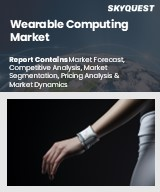
웨어러블 컴퓨팅 세계 시장 규모는 2023년에 674억 7,000만 달러로 평가되었으며, 2024년 811억 달러에서 2032년에는 3,533억 9,000만 달러로 성장하여 예측 기간(2025-2032년) 동안 CAGR 20.2%로 성장할 전망입니다.
웨어러블 컴퓨팅 시장은 건강 및 피트니스에 대한 인식 증가, 센서 기술 및 소형화의 급속한 발전, 헬스케어 분야에서의 적용 확대 등을 배경으로 큰 성장이 예상됩니다. 웨어러블과 IoT 생태계의 통합으로 웨어러블의 기능이 강화되는 한편, 제조, 물류, 현장 서비스 등 산업 전반에서 채택이 확대되어 안전과 업무 효율성이 향상되고 있습니다. 또한, 몰입감 있는 디지털 경험에 대한 수요가 증가하면서 웨어러블 기기와 증강현실 및 가상현실 기술의 융합이 가속화되고 있습니다. 그러나 고가의 고가 기기, 데이터 프라이버시 및 보안 문제, 제한된 배터리 수명, 표준화 부족, 잠재적인 건강 위험 등으로 인해 시장 확대에 어려움을 겪을 수 있습니다. 이러한 장애물에도 불구하고 장기적인 전망은 여전히 낙관적이며, 지속적인 기술 혁신으로 인해 소비자 및 기업 부문에서 모멘텀이 지속될 것으로 예상됩니다.
Global Wearable Computing Market size was valued at USD 67.47 billion in 2023 and is poised to grow from USD 81.1 billion in 2024 to USD 353.39 billion by 2032, growing at a CAGR of 20.2% during the forecast period (2025-2032).
The wearable computing market is poised for significant growth, driven by increasing health and fitness awareness, rapid advancements in sensor technologies and miniaturization, and expanding applications in the healthcare sector. The integration of wearables with IoT ecosystems is enhancing their functionality, while adoption across industries such as manufacturing, logistics, and field services is improving safety and operational efficiency. Additionally, the rising demand for immersive digital experiences is fueling the convergence of wearable devices with augmented and virtual reality technologies. However, market expansion may face challenges due to the high cost of advanced devices, data privacy and security concerns, limited battery life, lack of standardization, and potential health risks. Despite these barriers, the long-term outlook remains optimistic, with continued innovation expected to sustain momentum across consumer and enterprise segments.
Top-down and bottom-up approaches were used to estimate and validate the size of the Global Wearable Computing market and to estimate the size of various other dependent submarkets. The research methodology used to estimate the market size includes the following details: The key players in the market were identified through secondary research, and their market shares in the respective regions were determined through primary and secondary research. This entire procedure includes the study of the annual and financial reports of the top market players and extensive interviews for key insights from industry leaders such as CEOs, VPs, directors, and marketing executives. All percentage shares split, and breakdowns were determined using secondary sources and verified through Primary sources. All possible parameters that affect the markets covered in this research study have been accounted for, viewed in extensive detail, verified through primary research, and analyzed to get the final quantitative and qualitative data.
Global Wearable Computing Market Segments Analysis
Global Wearable Computing Market is segmented by Product Type, Connectivity, Application and region. Based on Product Type, the market is segmented into Smart Watches, Fitness Trackers, Head-Mounted Displays (HMDs), Smart Jewelry, Body-Worn Cameras, Smart Clothing and Others. Based on Connectivity, the market is segmented into Bluetooth, Wi-Fi, 4G/5G and Others. Based on Application, the market is segmented into Consumer and Non-Consumer. Based on region, the market is segmented into North America, Europe, Asia Pacific, Latin America and Middle East & Africa.
Driver of the Global Wearable Computing Market
The Global Wearable Computing market is witnessing remarkable growth driven by increasing investments in the research and development of innovative sensors, along with advancements in miniaturization techniques. These developments enhance the functionality of wearable devices, allowing them to support advanced features like ECG monitoring, GPS tracking, gesture recognition, and biometric authentication. Additionally, the reduction in size and weight of these miniaturized components contributes to improved device performance and extended battery life. Consequently, these technological innovations are essential for the ongoing evolution and expansion of the market, as they meet the growing demand for sophisticated wearable solutions.
Restraints in the Global Wearable Computing Market
The Global Wearable Computing market faces significant challenges due to growing concerns surrounding data privacy and security. These devices gather and retain sensitive personal information, including health metrics, locations, and biometric data. Issues related to data breaches, unauthorized access, and insufficient transparency regarding data usage contribute to a decline in consumer trust. Furthermore, many wearable devices often lack strong encryption protocols and comprehensive privacy settings, rendering them susceptible to hacking risks. This vulnerability not only deters potential users but also hampers the broader acceptance and adoption of wearable computing technology in the market.
Market Trends of the Global Wearable Computing Market
The Global Wearable Computing market is increasingly shifting towards the development of medical-grade devices, driven by rising demand for real-time health monitoring and remote diagnostics. As healthcare organizations and telemedicine platforms increasingly integrate wearables into patient care, companies are compelled to invest in research and development to create innovative, regulatory-compliant products. This trend not only presents an opportunity to differentiate from competitors but also facilitates the crossover between consumer electronics and the healthcare sector, ultimately expanding the market into high-value segments. With the focus on delivering reliable medical wearables, the industry is poised for significant growth in both consumer and healthcare applications.